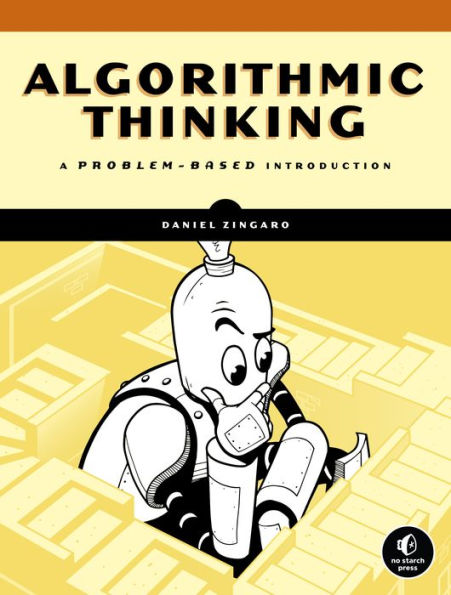Algorithmic Thinking: A Problem-Based Introduction
A hands-on, problem-based introduction to building algorithms and data structures to solve problems with a computer.
Algorithmic Thinking will teach you how to solve challenging programming problems and design your own algorithms. Daniel Zingaro, a master teacher, draws his examples from world-class programming competitions like USACO and IOI. You'll learn how to classify problems, choose data structures, and identify appropriate algorithms. You'll also learn how your choice of data structure, whether a hash table, heap, or tree, can affect runtime and speed up your algorithms; and how to adopt powerful strategies like recursion, dynamic programming, and binary search to solve challenging problems.
Line-by-line breakdowns of the code will teach you how to use algorithms and data structures like:The breadth-first search algorithm to find the optimal way to play a board game or find the best way to translate a book Dijkstra's algorithm to determine how many mice can exit a maze or the number of fastest routes between two locations The union-find data structure to answer questions about connections in a social network or determine who are friends or enemies The heap data structure to determine the amount of money given away in a promotion The hash-table data structure to determine whether snowflakes are unique or identify compound words in a dictionary
NOTE: Each problem in this book is available on a programming-judge website. You'll find the site's URL and problem ID in the description. What's better than a free correctness check?
1136585779
Algorithmic Thinking will teach you how to solve challenging programming problems and design your own algorithms. Daniel Zingaro, a master teacher, draws his examples from world-class programming competitions like USACO and IOI. You'll learn how to classify problems, choose data structures, and identify appropriate algorithms. You'll also learn how your choice of data structure, whether a hash table, heap, or tree, can affect runtime and speed up your algorithms; and how to adopt powerful strategies like recursion, dynamic programming, and binary search to solve challenging problems.
Line-by-line breakdowns of the code will teach you how to use algorithms and data structures like:
NOTE: Each problem in this book is available on a programming-judge website. You'll find the site's URL and problem ID in the description. What's better than a free correctness check?
Algorithmic Thinking: A Problem-Based Introduction
A hands-on, problem-based introduction to building algorithms and data structures to solve problems with a computer.
Algorithmic Thinking will teach you how to solve challenging programming problems and design your own algorithms. Daniel Zingaro, a master teacher, draws his examples from world-class programming competitions like USACO and IOI. You'll learn how to classify problems, choose data structures, and identify appropriate algorithms. You'll also learn how your choice of data structure, whether a hash table, heap, or tree, can affect runtime and speed up your algorithms; and how to adopt powerful strategies like recursion, dynamic programming, and binary search to solve challenging problems.
Line-by-line breakdowns of the code will teach you how to use algorithms and data structures like:The breadth-first search algorithm to find the optimal way to play a board game or find the best way to translate a book Dijkstra's algorithm to determine how many mice can exit a maze or the number of fastest routes between two locations The union-find data structure to answer questions about connections in a social network or determine who are friends or enemies The heap data structure to determine the amount of money given away in a promotion The hash-table data structure to determine whether snowflakes are unique or identify compound words in a dictionary
NOTE: Each problem in this book is available on a programming-judge website. You'll find the site's URL and problem ID in the description. What's better than a free correctness check?
Algorithmic Thinking will teach you how to solve challenging programming problems and design your own algorithms. Daniel Zingaro, a master teacher, draws his examples from world-class programming competitions like USACO and IOI. You'll learn how to classify problems, choose data structures, and identify appropriate algorithms. You'll also learn how your choice of data structure, whether a hash table, heap, or tree, can affect runtime and speed up your algorithms; and how to adopt powerful strategies like recursion, dynamic programming, and binary search to solve challenging problems.
Line-by-line breakdowns of the code will teach you how to use algorithms and data structures like:
NOTE: Each problem in this book is available on a programming-judge website. You'll find the site's URL and problem ID in the description. What's better than a free correctness check?
49.95
In Stock
5
1

Algorithmic Thinking: A Problem-Based Introduction
408
Algorithmic Thinking: A Problem-Based Introduction
408Paperback
$49.95
49.95
In Stock

Product Details
| ISBN-13: | 9781718500808 |
|---|---|
| Publisher: | No Starch Press |
| Publication date: | 12/15/2020 |
| Pages: | 408 |
| Product dimensions: | 9.10(w) x 6.90(h) x 1.10(d) |
About the Author
From the B&N Reads Blog
